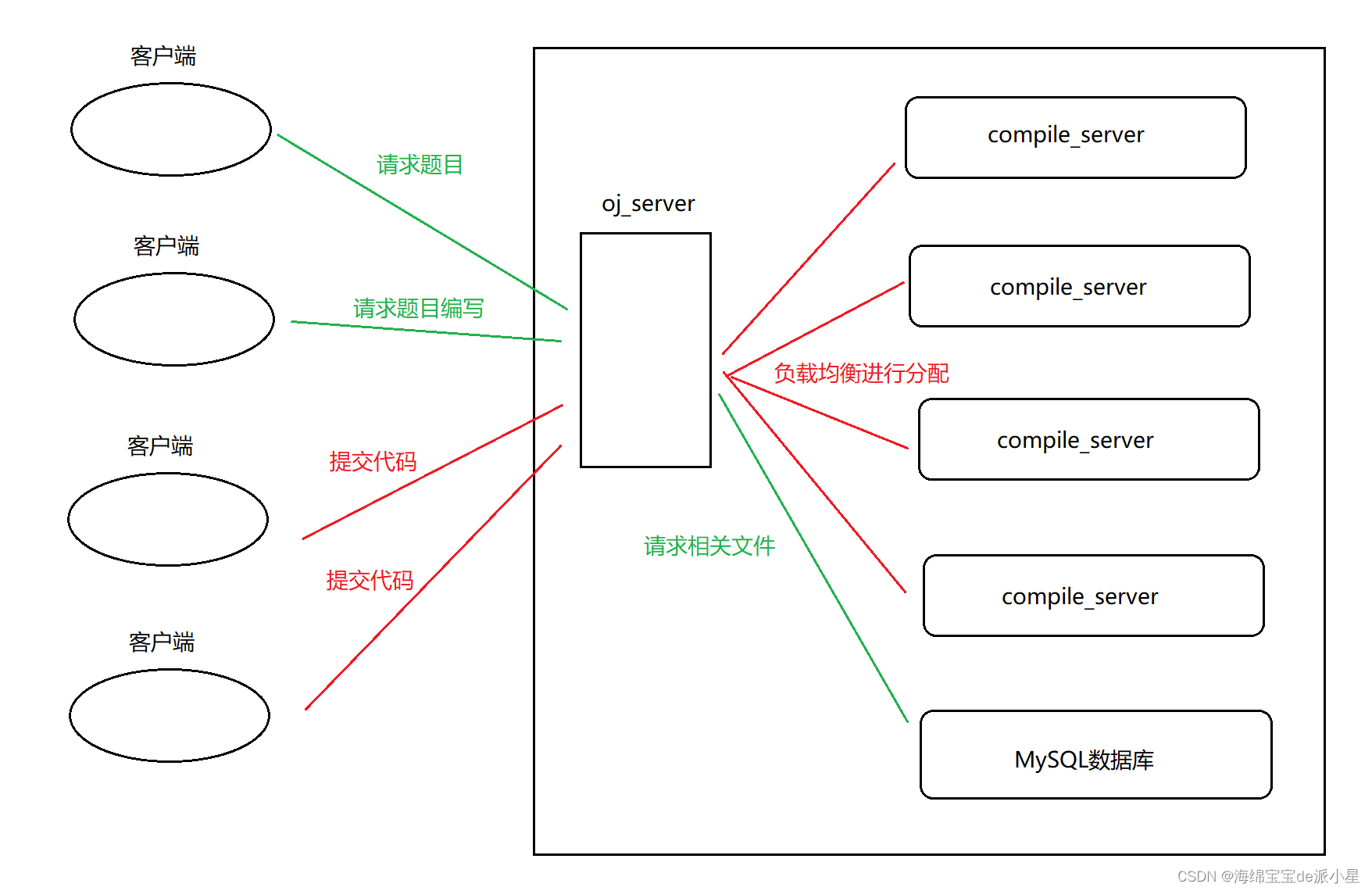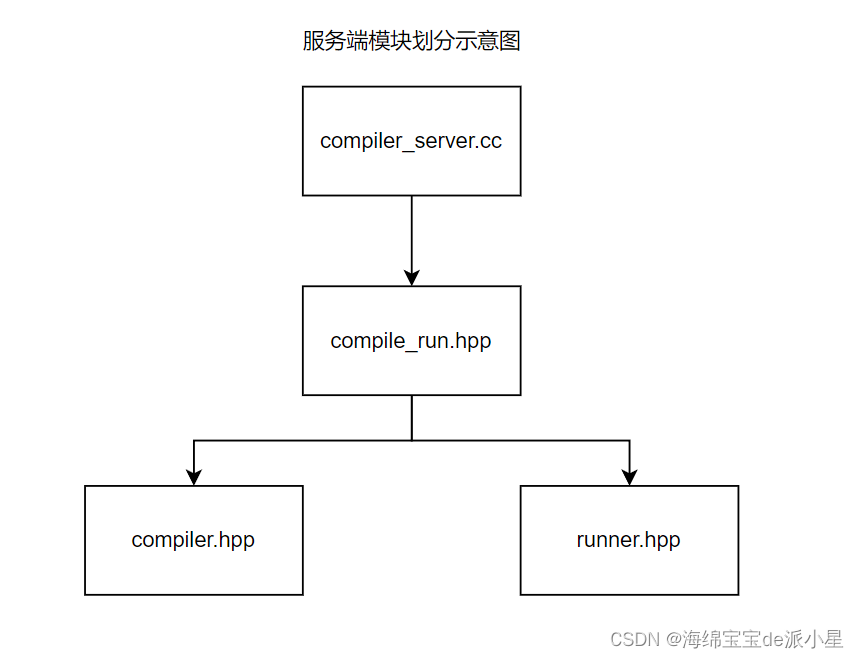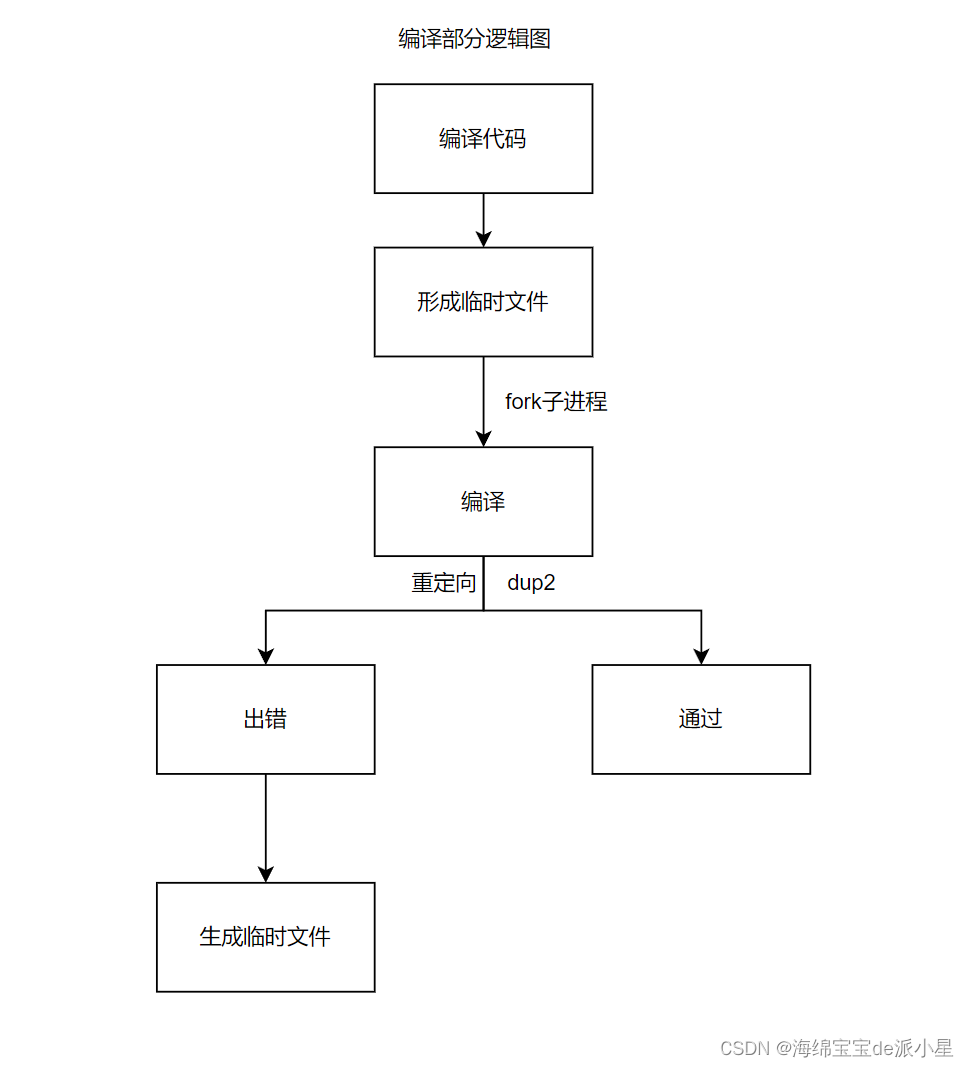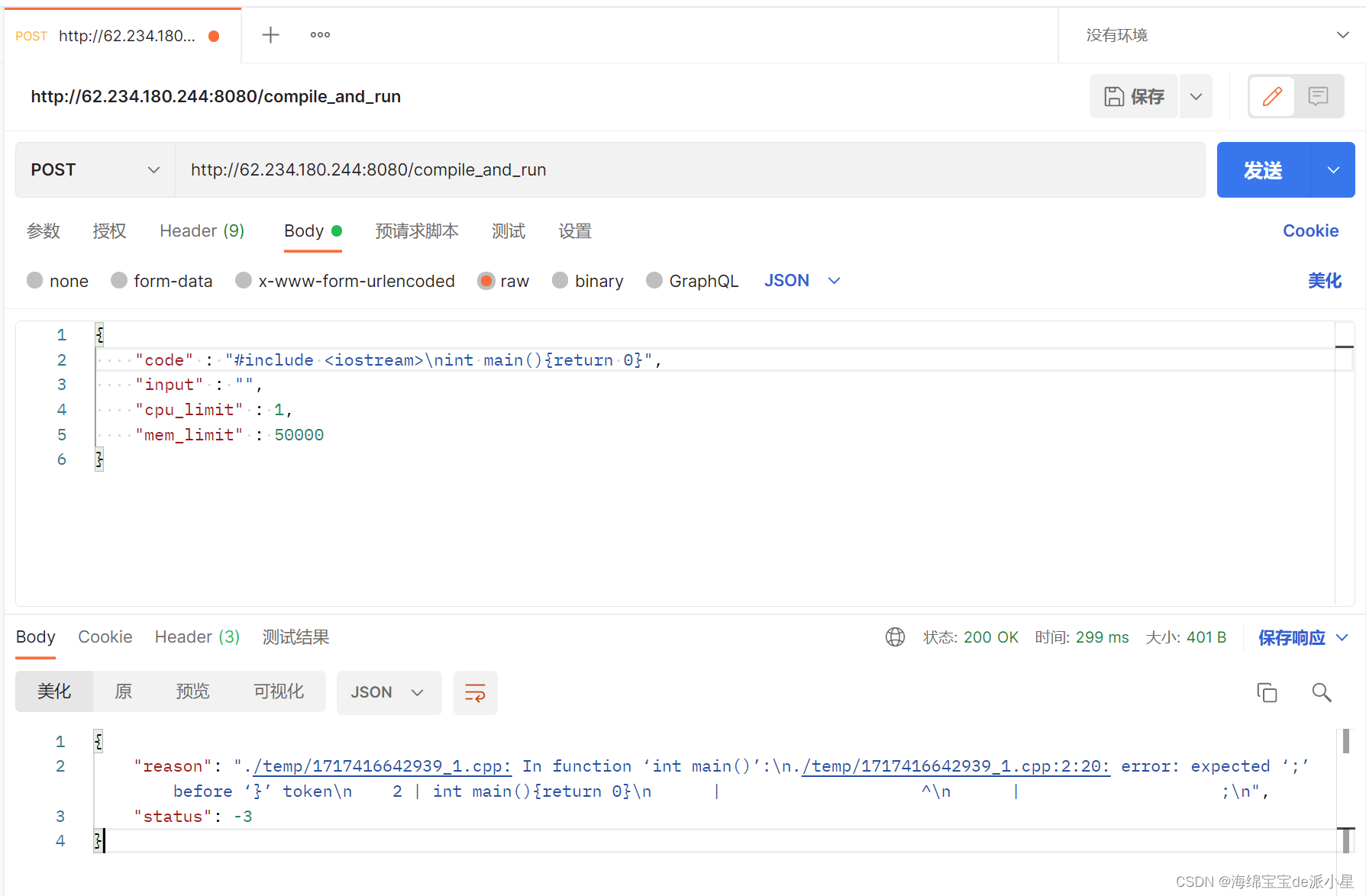项目:基于httplib/消息队列负载均衡式在线OJ
文章目录
- 写在前面
- 关于组件
- 开源仓库和项目上线
- 其他文档说明
- 项目亮点
- 使用技术和环境
- 项目宏观结构
- 模块实现
- compiler模块
- runner模块
- compile_run模块
- compile_server模块
- 基于MVC结构的OJ服务
- 什么是MVC?
- 用户请求服务路由功能
- Model模块
- view模块
- Control模块
写在前面
关于组件
本项目使用的是一个仿RabbitMQ消息队列组件,关于该组件的细节内容在下面的链接中:
项目:仿RabbitMQ实现的消息队列组件
开源仓库和项目上线
本项目已开源到下面链接下的仓库当中
负载均衡式在线OJ
并且项目已经部署在了Linux服务器上,具体访问方式可以点击下面链接进行访问:
111.230.81.226:8080
其他文档说明
针对于日志的信息,我采用了之前写的一份利用可变参数实现日志的代码,具体链接如下
C++:可变参数实现日志系统
项目:仿RabbitMQ实现的消息队列组件
项目亮点
从技术栈的角度来讲,用的比较多,这里实现了两个版本,一个是httplib版本,在将请求从服务端发送到编译模块的部分是采用了httplib来进行发送的,而第二个版本采用的是消息队列的方式,服务端作为的是生产者,把数据推送到指定的队列,而编译模块作为消费者,来把数据进行编译后写入到Redis中,这样服务端只需要从Redis中获取数据即可
使用技术和环境
本项目使用的技术主要有:
- C++STL
- Boost标准库
- cpp-httplib网络库
- JSON序列化反序列化库
- Redis
- 消息队列
开发环境:
- Ubuntu22.04云服务器
- vscode
项目宏观结构
对于项目来说,核心的部分其实就是三个模块:
- common:存储的是一些公共的功能
- compile_server:编译运行模块
- oj_server:获取题目列表,查看界面,负载均衡等功能
具体的逻辑图如下所示:
对于客户端来说,会把所有的请求都发布到oj_server上,而oj_server就会把这些请求进行合理的分配,分配到各个地方进行各自的处理,其中对于请求题目和编写这样的内容不算特别吃资源,因此直接正常进行使用即可,而对于进行判定这样的操作,对于CPU的占用比较大,因此就需要使用负载均衡这样的策略,分配到各自的服务器主机上进行判定,达到一个负载均衡的效果

模块实现
下面进行模块的介绍实现,先说服务端,服务端主要包含下面的几个模块:

compiler模块
对于在线OJ来说,编译模块是必不可少的,那对于编译的具体逻辑,简单来说就是远端把代码提交到后端,此时会生成一个临时文件,而对于临时文件来说,就会进行编译的操作,编译失败,就把失败的信息生成,如果编译成功就继续执行,具体流程可以总结如下:

具体实现如下所示:
#pragma once
#include
#include
#include
#include
#include
#include "../common/util.hpp"
#include "../common/Log.hpp"
// 只负责进行代码的编译
class Compiler
{
public:
Compiler()
{}
~Compiler()
{}
static bool Compile(const string &file_name)
{
pid_t pid = fork();
if(pid < 0)
{
lg(Error, "内部错误,创建子进程失败");
return false;
}
else if (pid == 0)
{
umask(0);
int _stderr = open(PathUtil::CompilerError(file_name).c_str(), O_CREAT | O_WRONLY, 0644);
if(_stderr < 0)
{
lg(Warning, "没有生成stderr文件");
exit(1);
}
dup2(_stderr, 2);
//g++ -o target src -std=c++11
execlp("g++", "g++", "-o", PathUtil::Exe(file_name).c_str(),\
PathUtil::Src(file_name).c_str(), "-D", "COMPILER_ONLINE","-std=c++11", nullptr);
lg(Error, "启动编译器失败");
exit(2);
}
else
{
waitpid(pid, nullptr, 0);
// 编译是否成功,就看有没有形成对应的可执行程序
if(FileUtil::IsFileExists(PathUtil::Exe(file_name)))
{
lg(Info, "%s:编译成功", PathUtil::Src(file_name).c_str());
return true;
}
}
lg(Error, "编译失败");
return false;
}
};
runner模块
编译了之后,就要运行了,因此下面这个模块就是运行模块
进程占用资源
对于在线OJ来说,其实是有时间复杂度和空间复杂度的需求的,因此我们也需要设置对应的接口,想要对于资源进行限制,需要用到的系统调用是setrlimit

对于这个接口来说,比较重要的参数就是这个结构体了:

这个结构体就是做出了对于软件和硬件的限制,总的来说这个系统调用还是比较简单的,我们需要限定CPU的时长和内存大小,需要用到的参数是RLIMIT_CPU和RLIMIT_AS
//提供设置进程占用资源大小的接口
static void SetProcLimit(int _cpu_limit, int _mem_limit)
{
// 设置CPU时长
struct rlimit cpu_rlimit;
cpu_rlimit.rlim_max = RLIM_INFINITY;
cpu_rlimit.rlim_cur = _cpu_limit;
setrlimit(RLIMIT_CPU, &cpu_rlimit);
// 设置内存大小
struct rlimit mem_rlimit;
mem_rlimit.rlim_max = RLIM_INFINITY;
mem_rlimit.rlim_cur = _mem_limit * 1024; //转化成为KB
setrlimit(RLIMIT_AS, &mem_rlimit);
}
程序运行
接下来就是让程序进行运行了,程序运行主要有三种情况:
- 代码跑完,结果正确
- 代码跑完,结果不正确
- 代码没跑完,异常了
那在运行模块,我们只管新的是程序有没有正常跑完,只要跑完了就可以,至于结果正确还是不正确,并不是这里关心的重点,因此在这个模块中,其实也需要有标准输出和标准错误两个模块,这两个模块当中记录的是到底有没有正常结束的信息
static int Run(const string &file_name, int cpu_limit, int mem_limit)
{
string _execute = PathUtil::Exe(file_name);
string _stdin = PathUtil::Stdin(file_name);
string _stdout = PathUtil::Stdout(file_name);
string _stderr = PathUtil::Stderr(file_name);
umask(0);
int _stdin_fd = open(_stdin.c_str(), O_CREAT|O_RDONLY, 0644);
int _stdout_fd = open(_stdout.c_str(), O_CREAT|O_WRONLY, 0644);
int _stderr_fd = open(_stderr.c_str(), O_CREAT|O_WRONLY, 0644);
if(_stdin_fd < 0 || _stdout_fd < 0 || _stderr_fd < 0)
{
lg(Error, "打开标准文件失败");
return -1; //代表打开文件失败
}
pid_t pid = fork();
if (pid < 0)
{
lg(Error, "创建子进程失败");
close(_stdin_fd);
close(_stdout_fd);
close(_stderr_fd);
return -2; //代表创建子进程失败
}
else if (pid == 0)
{
dup2(_stdin_fd, 0);
dup2(_stdout_fd, 1);
dup2(_stderr_fd, 2);
SetProcLimit(cpu_limit, mem_limit);
execl(_execute.c_str()/*执行谁*/, _execute.c_str()/*如何执行该程序*/, nullptr);
exit(1);
}
else
{
close(_stdin_fd);
close(_stdout_fd);
close(_stderr_fd);
int status = 0;
waitpid(pid, &status, 0);
// 输出信号信息
lg(Info, "运行结束,info:%d", (status & 0x7F));
return status & 0x7F;
}
}
compile_run模块
下面是进行compile_run模块,这个模块就是对于之前内容的整合,同时借助JSON完成序列化和反序列化的内容
对于序列化和反序列化来说,要传递的参数其实比较简单:
输入
- code:用户提交的代码
- input:用户给代码做的输入
- cpu_limit:时间要求
- mem_limit:空间要求
输出
- status:状态码
- reason:请求结果
- stdout:运行结果
- stderr:错误结果
所以在JSON中,它的组织形式更像是:
in_json: {"code": "#include...", "input": "","cpu_limit":1, "mem_limit":10240}
out_json: {"status":"0", "reason":"","stdout":"","stderr":"",}
资源清理
在本项目中的策略是把创建的临时文件都放到一个temp文件夹路径下,而当运行结果结束之后,也就没有存在的必要了,因此就需要显示的把这些临时文件都清理掉,所以是需要一个垃圾回收的机制存在的
代码实现如下:
#pragma once
#include "compiler.hpp"
#include "runner.hpp"
#include "../common/util.hpp"
#include
#include
#include
using namespace std;
class CompileAndRun
{
public:
static void RemoveTempFile(const string &file_name)
{
// 清理文件的个数是不确定的,但是有哪些我们是知道的
string _src = PathUtil::Src(file_name);
if(FileUtil::IsFileExists(_src))
unlink(_src.c_str());
string _compiler_error = PathUtil::CompilerError(file_name);
if(FileUtil::IsFileExists(_compiler_error))
unlink(_compiler_error.c_str());
string _execute = PathUtil::Exe(file_name);
if(FileUtil::IsFileExists(_execute))
unlink(_execute.c_str());
string _stdin = PathUtil::Stdin(file_name);
if(FileUtil::IsFileExists(_stdin))
unlink(_stdin.c_str());
string _stdout = PathUtil::Stdout(file_name);
if(FileUtil::IsFileExists(_stdout))
unlink(_stdout.c_str());
string _stderr = PathUtil::Stderr(file_name);
if(FileUtil::IsFileExists(_stderr))
unlink(_stderr.c_str());
}
// code > 0 : 进程收到了信号导致异常奔溃
// code < 0 : 整个过程非运行报错(代码为空,编译报错等)
// code = 0 : 整个过程全部完成
static string CodeToDesc(int code, const string &file_name)
{
string desc;
switch (code)
{
case 0:
desc = "编译运行成功";
break;
case -1:
desc = "提交的代码是空";
break;
case -2:
desc = "未知错误";
break;
case -3:
// desc = "代码编译的时候发生了错误";
FileUtil::ReadFile(PathUtil::CompilerError(file_name), &desc, true);
break;
case SIGABRT: // 6
desc = "内存超过范围";
break;
case SIGXCPU: // 24
desc = "CPU使用超时";
break;
case SIGFPE: // 8
desc = "浮点数溢出";
break;
default:
desc = "未知: " + to_string(code);
break;
}
return desc;
}
static void Start(const string &in_json, string *out_json)
{
Json::Value in_value;
Json::Reader reader;
reader.parse(in_json, in_value);
string code = in_value["code"].asString();
string input = in_value["input"].asString();
int cpu_limit = in_value["cpu_limit"].asInt();
int mem_limit = in_value["mem_limit"].asInt();
int status_code = 0;
Json::Value out_value;
int run_result = 0;
string file_name;
if (code.size() == 0)
{
status_code = -1;
goto END;
}
file_name = FileUtil::UniqFileName();
//形成临时src文件
if (!FileUtil::WriteFile(PathUtil::Src(file_name), code))
{
status_code = -2; //未知错误
goto END;
}
if (!Compiler::Compile(file_name))
{
//编译失败
status_code = -3; //代码编译的时候发生了错误
goto END;
}
run_result = Runner::Run(file_name, cpu_limit, mem_limit);
if (run_result < 0)
{
status_code = -2; //未知错误
}
else if (run_result > 0)
{
//程序运行崩溃了
status_code = run_result;
}
else
{
//运行成功
status_code = 0;
}
END:
out_value["status"] = status_code;
out_value["reason"] = CodeToDesc(status_code, file_name);
if (status_code == 0)
{
// 整个过程全部成功
string _stdout;
FileUtil::ReadFile(PathUtil::Stdout(file_name), &_stdout, true);
out_value["stdout"] = _stdout;
string _stderr;
FileUtil::ReadFile(PathUtil::Stderr(file_name), &_stderr, true);
out_value["stderr"] = _stderr;
}
Json::StyledWriter writer;
*out_json = writer.write(out_value);
RemoveTempFile(file_name);
}
};
compile_server模块
下面借助httplib,实现一个基础版本的服务器,httplib是一个简单的封装好的服务器库,这里直接进行使用:
#include "../common/httplib.h"
#include "compile_run.hpp"
using namespace std;
void Usage(std::string proc)
{
std::cerr << "Usage: " << "
" << proc << " port" << std::endl;
}
//./compile_server port
int main(int argc, char *argv[])
{
if(argc != 2)
{
Usage(argv[0]);
return 1;
}
httplib::Server svr;
svr.Post("/compile_and_run", [](const httplib::Request &req, httplib::Response &resp){
// 用户请求的服务正文是我们想要的json string
std::string in_json = req.body;
std::string out_json;
if(!in_json.empty())
{
CompileAndRun::Start(in_json, &out_json);
resp.set_content(out_json, "application/json;charset=utf-8");
}
});
svr.listen("0.0.0.0", atoi(argv[1]));
return 0;
}
利用postman尝试进行测试,发现测试是可以通过的,代码正常运行:

基于MVC结构的OJ服务
什么是MVC?
对于MVC来说,M的意思是Model,通常是和数据进行交互的模块,比如对于题库进行增删改查,而V的意思是View,意思是利用数据进行构建网页和渲染网页内容,展示给用户对应的信息,最后C的意思是Control,控制器控制的是核心业务逻辑
下面的步骤,是要搭建一个小型网站,具体步骤如下:
- 获取首页信息
- 编辑区域页面
- 提交判题功能
下面就基于这些内容,进行代码的编写
用户请求服务路由功能
这个部分内容相对简单,就是借助httplib进行服务的调用
#include
#include "../common/httplib.h"
using namespace std;
int main()
{
httplib::Server svr;
svr.Get("/all_questions", [](const httplib::Request &req, httplib::Response &resp){
resp.set_content("这是所有题⽬的列表", "text/plain; charset=utf-8");
});
svr.Get(R"(/question/(\d+))", [](const httplib::Request &req, httplib::Response &resp){
std::string number = req.matches[1];
resp.set_content("这是指定的⼀道题: " + number, "text/plain; charset=utf-8");
});
svr.Get(R"(/judge/(\d+))", [](const httplib::Request &req, httplib::Response &resp){
std::string number = req.matches[1];
resp.set_content("指定题⽬的判题: " + number, "text/plain; charset=utf-8");
});
svr.set_base_dir("./wwwroot");
svr.listen("0.0.0.0", 8080);
return 0;
}
上述只是进行了一个最基础的操作,进行了一个框架的搭建,那么下面就进入MVC的模块
Model模块
Model模块,提供对于数据的一系列操作
对于这个项目的数据来说,最重要的就是题目的一些数据,这里枚举出题目的细节信息:
struct Question
{
string number;
string title;
string star;
int cpu_limit;
int mem_limit;
string desc;
// 题目预设给用户在线编辑器的代码
string header;
// 题目的测试用例,需要和header拼接,形成完整代码
string tail;
};
实际上,在进行OJ的过程中,基本的逻辑思路很简单,把用户提交上来的代码和测试用例进行拼接,再执行,把执行的结果和测试用例进行比较,即可得到结果,这就是项目的底层逻辑
那么有了这样的思想,实现出Model模块逻辑就很轻松了,下面进行具体的实现过程:
class Model
{
private:
//题号 : 题目细节
unordered_map<string, Question> questions;
public:
Model();
bool LoadQuestionList(const string &question_list);
bool GetAllQuestions(vector<Question> *out);
bool GetOneQuestion(const string &number, Question *q);
~Model()
{}
};
view模块
view模块这里采取的是ctemplate中的渲染网页部分,它的基本思想就是实现一个key,value的值替换,达到渲染网页的目的
#pragma once
#include
#include
#include
#include "oj_model.hpp"
using namespace std;
const string template_path = "./template_html/";
class View
{
public:
View(){}
~View(){}
public:
void AllExpandHtml(const vector<struct Question> &questions, string *html)
{
// 题目的编号 题目的标题 题目的难度
// 推荐使用表格显示
// 1. 形成路径
string src_html = template_path + "all_questions.html";
// 2. 形成数字典
ctemplate::TemplateDictionary root("all_questions");
for (const auto& q : questions)
{
ctemplate::TemplateDictionary *sub = root.AddSectionDictionary("question_list");
sub->SetValue("number", q.number);
sub->SetValue("title", q.title);
sub->SetValue("star", q.star);
}
//3. 获取被渲染的html
ctemplate::Template *tpl = ctemplate::Template::GetTemplate(src_html, ctemplate::DO_NOT_STRIP);
//4. 开始完成渲染功能
tpl->Expand(html, &root);
}
void OneExpandHtml(const struct Question &q, string *html)
{
// 1. 形成路径
string src_html = template_path + "one_question.html";
// 2. 形成数字典
ctemplate::TemplateDictionary root("one_question");
root.SetValue("number", q.number);
root.SetValue("title", q.title);
root.SetValue("star", q.star);
root.SetValue("desc", q.desc);
root.SetValue("pre_code", q.header);
//3. 获取被渲染的html
ctemplate::Template *tpl = ctemplate::Template::GetTemplate(src_html, ctemplate::DO_NOT_STRIP);
//4. 开始完成渲染功能
tpl->Expand(html, &root);
}
};
Control模块
最后进入Control模块
对于Control模块来说,基本的调用逻辑为:
- 把in_json进行反序列化,得到题目id和源代码,input等
- 重新拼接用户代码和测试代码,可以得到一个新的代码
- 把新的代码给负载最低的主机,发起http请求把结果传输过去
- 把结果赋值给out_json即可
选择主机
主机如何选择呢?
在本项目中,提供的方法是使用轮询方式实现的负载均衡,对比所有的主机寻找一个负载最少的进行判断即可
由于要实现负载均衡,所以在进行实际的使用过程中,要对于负载均衡有体现,在实际的运行中,理应拥有几个服务器一起进行负载均衡,那对于这些服务器的管理是有必要的,所以就要先对提供服务的主机进行管理:
// 提供服务的主机
class Machine
{
public:
string ip; //编译服务的ip
int port; //编译服务的port
uint64_t load; //编译服务的负载
mutex *mtx; // mutex禁止拷贝的,使用指针
public:
Machine() : ip(""), port(0), load(0), mtx(nullptr)
{
}
~Machine()
{
}
public:
// 提升主机负载
void IncLoad()
{
if (mtx)
mtx->lock();
++load;
if (mtx)
mtx->unlock();
}
// 减少主机负载
void DecLoad()
{
if (mtx)
mtx->lock();
--load;
if (mtx)
mtx->unlock();
}
void ResetLoad()
{
if(mtx)
mtx->lock();
load = 0;
if(mtx)
mtx->unlock();
}
// 获取主机负载
uint64_t Load()
{
uint64_t _load = 0;
if (mtx)
mtx->lock();
_load = load;
if (mtx)
mtx->unlock();
return _load;
}
};
之后,实现负载均衡,由于篇幅的原因这里把最核心的展示出来:
// 选择主机和机器
bool SmartChoice(int *id, Machine **m)
{
// 1. 使用选择好的主机(更新该主机的负载)
// 2. 需要可能离线该主机
mtx.lock();
// 负载均衡的算法: 轮询
int online_num = online.size();
if (online_num == 0)
{
mtx.unlock();
lg(Fatal, "后端所有主机离线");
return false;
}
// 通过遍历的方式,找到所有负载最小的机器
*id = online[0];
*m = &machines[online[0]];
uint64_t min_load = machines[online[0]].Load();
for (int i = 1; i < online_num; i++)
{
// 获取主机的负载,如果负载小就更新
uint64_t curr_load = machines[online[i]].Load();
if (min_load > curr_load)
{
min_load = curr_load;
*id = online[i];
*m = &machines[online[i]];
}
}
mtx.unlock();
return true;
}
有了这两个模块,就可以去实现出Control模块了,这个是整个业务最核心的模块,它用到了Model模块来提供业务数据,view实现html渲染,还有负载均衡
// 这是我们的核心业务逻辑的控制器
class Control
{
void RecoveryMachine()
{
load_blance_.OnlineMachine();
}
//根据题目数据构建网页
// html: 输出型参数
bool AllQuestions(string *html);
bool Question(const string &number, string *html);
// code: #include...
// input: ""
void Judge(const string &number, const string in_json, string *out_json)
{
// 0. 根据题目编号,直接拿到对应的题目细节
// 1. in_json进行反序列化,得到题目的id,得到用户提交源代码,input
// 2. 重新拼接用户代码+测试用例代码,形成新的代码
// 3. 选择负载最低的主机(差错处理)
// 规则: 一直选择,直到主机可用,否则,就是全部挂掉
// 4. 然后发起http请求,得到结果
// 5. 将结果赋值给out_json
}
};
这样,整个项目的最基础的业务逻辑就使用结束了




